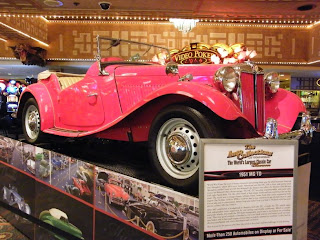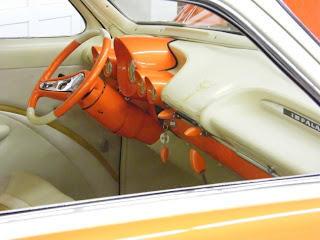On a recent Monday in May, 2009, I had to judge a camera club competition in Manhattan at 7:30 PM. Rather than drive or take the train into the city during rush hours, I decided to make a day of it and pay another visit to the New York City Archives, on Chambers Street. The main attraction for me are the thousands of old file photos of buildings within the five boroughs, taken between 1939 and 1941, for property tax purposes and available to the public. (Please check out my earlier entry on this blog for more about the NYC Archives.)
I took the Long Island Rail Road out of Hicksville, then the "A" train to Chambers Street, a few blocks from the Surrogates Court Building where the archives are located. I planned on arriving in time for lunch so I ate a sandwich I had brought along while relaxing in the park across the street from the court building.
The last time I visited the archives, I had addresses from old homes in Brooklyn that various members of my family lived in during the early 1900s; luckily, I found most of what I was looking for. This time, I was searching for buildings and businesses I remember from the Richmond Hill, Queens, area that I remember from growing up there in the late 1940s and 1950s.
I figured if I could find a 1940 photo of a place that I remember from the 1950s, chances are it would look the same. I was fairly successful, although the quality of the photos is pretty poor to begin with and I had to print out a paper negative at the archives before turning it into a positive image on my computer. I thought about going back to Queens and photographing some of the sites the way they look today, to compare how certain scenes look compared to the 1940s. But, many of the buildings I sought to find are still standing; they're just not occupied by the former shops and proprietors so I didn't think it was worth the effort.
If you grew up in Richmond Hill, or the surrounding areas like Ozone Park or Jamaica, you'll probably recognize many of the following scenes. If you were not from the area, maybe you'll still appreciate a look back at the way Queens was in the early twentieth century.

Hattie & Nettie's "general store" was built at 127-10,
95th Avenue, before 1900 and
before any other houses were built on the block!
(Click on any photo to enlarge.)

Groulings (sp?) Bakery (on the left) was at the corner of 127th Street
& 101st Avenue (formerly Jerome Avenue and,
before that,
Broadway!)
There was a barber shop next door around 1940 but
it moved a couple of doors to the right (east) and
became "Tony's" when I was growing up in that area
during the 1950's.

The Casino movie theater was located just west of
114th Street on Liberty Avenue under the "el."

The Lefferts movie theater was located at
122nd Street & Liberty Avenue.

The "Triple AAA Stores" auto store, circa 1940;
I worked in that store part time
from 1959 up to the late 1960s for the owner, Sid Ableson.

I remember a Times Square store on the corner of
Woodhaven & Rockaway B'lvds
but I don't think this is it (it's not on a corner).
If anyone remembers where this was, please let me know.

I also don't remember where Becklers candy store was
so, once again, if you remember it, let me know.

This is the Woodhaven Junction station
(Woodhaven B'lvd & Atlantic Avenue),
around 1900, when the LIRR tracks were still above ground.

The Clarenceville station, around 1900, at
111th Street & Atlantic Avenue.
(That part of present day Richmond Hill
was originally called Clarenceville.)

The Morris Park LIRR station,
at Lefferts B'lvd & Atlantic Avenue, 1900.
(Yes, that section was originally called Morris Park.)

A rare photo of a rare LIRR station: Dunton!
The part of present day Richmond Hill,
from 126th Street to Van Wyck B'lvd
(today, the Van Wyck Expressway)
was originally called Dunton.
This was at Atlantic Avenue & Van Wyck B'lvd, circa 1922.
(Please see my earlier blog entry
for more on Dunton, Morris Park & Clarenceville.)
Sheffield's Milk Company (Atlantic Ave., from 130th Street to
about 134th Street, in 1935- shortly after it was built

Another view of Sheffield's, this time looking east, in 1936.

The Parish House for St. Benedict Joseph, Labre,
Catholic church in 1938.

The "annex" for P.S. 57, at 101-23, 124th Street, in 1938.
The main school building can be seen
on the left edge of the photo.

On this portion of a 1900 map (above)
of the Dunton/Morris Park area,
you can see the engineer's blue lines at the top
outlining where the widened Atlantic Avenue would be
(drawn in around 1930, before the work was performed)
with its familiar "S" turn by 129th & 130th Street (Maure Ave.)
I've indicated in red type the current avenues,
drawn a large square around what became
Smokey Park, and a small rectangle around the block
which housed a body shop and the Atlantic Auto Parts store
during the 1950s. Wickes was to become 127th Street;
Villa, 126th; and Cochran, 125th Street.
I've drawn a thin black oval with an arrow pointing to
the location of Hattie & Netties store
(
store seen in first photo, near top of this post).
One of the blocks that comprised Smokey Park,
also built in the 1930s, is enlarged below.
There were very few homes in the area at the time
as evidenced by the lack of yellow boxes on the lots.
 (Map photographed from archival bookat Queensborough Library.)
(Map photographed from archival bookat Queensborough Library.)If you're enjoying my blogs, consider signing on
to "follow" them and please pass along
the web addresses to others
who might appreciate them.
Questions, comments and corrections
are always welcome.
 The town of Wildbad (or Bad Wildbad) in Germany
The town of Wildbad (or Bad Wildbad) in Germany




















































